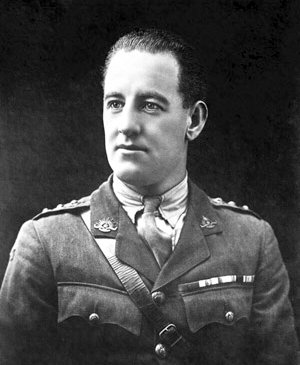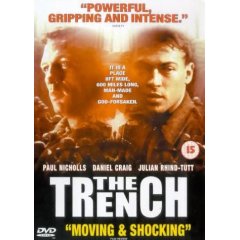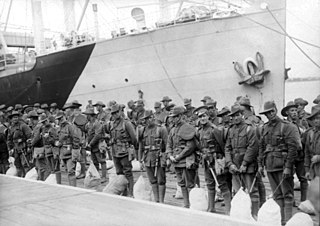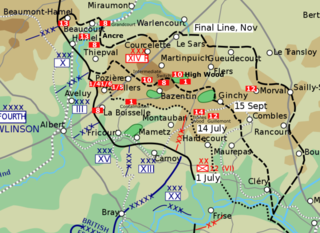Related Research Articles

The Battle of the Somme, also known as the Somme offensive, was a battle of the First World War fought by the armies of the British Empire and the French Third Republic against the German Empire. It took place between 1 July and 18 November 1916 on both sides of the upper reaches of the river Somme in France. The battle was intended to hasten a victory for the Allies. More than three million men fought in the battle, of whom one million were either wounded or killed, making it one of the deadliest battles in all of human history.
The British Expeditionary Force (BEF) was the six-divisions the British Army sent to the Western Front during the First World War. Planning for a British Expeditionary Force began with the 1906–1912 Haldane Reforms of the British Army carried out by the Secretary of State for War Richard Haldane following the Second Boer War (1899–1902).

The New Zealand Division was an infantry division of the New Zealand Expeditionary Force raised for service in the First World War. It was formed in Egypt in early 1916 when the New Zealand and Australian Division was renamed after the detachment of its Australian personnel left the New Zealand Infantry Brigade, together with reinforcements from New Zealand, as the basis of the division. It was commanded by Major General Andrew Hamilton Russell for the duration of the war.
The 36th (Ulster) Division was an infantry division of the British Army, part of Lord Kitchener's New Army, formed in September 1914. Originally called the Ulster Division, it was made up of mainly members of the Ulster Volunteer Force, who formed thirteen additional battalions for three existing regiments: the Royal Irish Fusiliers, the Royal Irish Rifles and the Royal Inniskilling Fusiliers. The division served from October 1915 on Western Front as a formation of the British Army during the Great War.

Albert Jacka, was an Australian recipient of the Victoria Cross, the highest decoration for gallantry "in the face of the enemy" that can be awarded to members of the British and Commonwealth armed forces. Jacka was the first Australian to be decorated with the VC during the First World War, receiving the medal for his actions during the Gallipoli Campaign. He later served on the Western Front and was twice more decorated for his bravery.

The Battle of Arras was a British offensive on the Western Front during the First World War. From 9 April to 16 May 1917, British troops attacked German defences near the French city of Arras on the Western Front. The British achieved the longest advance since trench warfare had begun, surpassing the record set by the French Sixth Army on 1 July 1916. The British advance slowed in the next few days and the German defence recovered. The battle became a costly stalemate for both sides and by the end of the battle, the British Third Army and the First Army had suffered about 160,000 casualties and the German 6th Army about 125,000.

Eric Norman Frankland Bell VC was an Irish recipient of the Victoria Cross, the highest and most prestigious award for gallantry in the face of the enemy that can be awarded to British and Commonwealth forces. A soldier with The Royal Inniskilling Fusiliers during the First World War, he was posthumously awarded the VC for his actions on 1 July 1916, during the Battle of the Somme.

Donald Forrester Brown, VC was a New Zealand recipient of the Victoria Cross (VC), the highest award for valour "in the face of the enemy" that can be awarded to British and Commonwealth forces.

Harry Cator VC, MM was an English recipient of the Victoria Cross, the highest and most prestigious award for gallantry in the face of the enemy that can be awarded to British and Commonwealth forces.
Lewis McGee, VC was an Australian recipient of the Victoria Cross, the highest decoration for gallantry "in the face of the enemy" that can be awarded to members of the British and Commonwealth armed forces. As a sergeant in the Australian Imperial Force, McGee was awarded the Victoria Cross for his actions in the Battle of Broodseinde—part of the Passchendaele offensive—on 4 October 1917. As his platoon came under heavy machine gun fire from a German pillbox, McGee rushed alone across open ground towards the emplacement. Armed solely with a revolver, he shot the gunners and captured the garrison. He then organised a bombing party, and led the group in the seizure of a second machine gun post.

David Jones VC was an English recipient of the Victoria Cross, the highest and most prestigious award for gallantry in the face of the enemy that can be awarded to British and Commonwealth forces. A soldier with The King's (Liverpool) Regiment during the First World War, he was awarded the VC for his actions in September 1916, during the Battle of the Somme. He was killed in action several days later.
Joe Colquhoun was a British comics artist best known for his work on Charley's War in Battle Picture Weekly. He was also the first artist to draw Roy of the Rovers.

The Liverpool Scottish, known as "the Scottish", was a unit of the British Army, part of the Army Reserve, raised in 1900 as an infantry battalion of the King's. The Liverpool Scottish became affiliated to the Queen's Own Cameron Highlanders in the 1920s and formally transferred to the regiment in 1937 with its identity preserved. Reflecting the Territorial Army's decline in size since the late 1940s, the battalion was reduced to a company in 1967, then to a platoon of "A" (King's) Company, King's and Cheshire Regiment in 1999. In 2006, the company was incorporated into the 4th Battalion, Duke of Lancaster's Regiment.

The Trench is a 1999 war film written and directed by William Boyd and starring Paul Nicholls and Daniel Craig. It depicts the experiences of a group of young British soldiers in the 48 hours leading up to the Battle of the Somme in 1916.

The British Army during the First World War fought the largest and most costly war in its long history. Unlike the French and German Armies, the British Army was made up exclusively of volunteers—as opposed to conscripts—at the beginning of the conflict. Furthermore, the British Army was considerably smaller than its French and German counterparts.

The 40th Battalion was an infantry battalion of the Australian Army. Raised in 1916 as part of the Australian Imperial Force during the First World War, the battalion was recruited completely from Tasmania as part of the 10th Brigade, 3rd Division. During the war the battalion served in the trenches along the Western Front and had the distinction of having two of its members awarded the Victoria Cross. The battalion was disbanded in 1919, however was re-raised in 1921 as part of the Citizens Force, serving as a part-time unit in Tasmania throughout the inter-war years. During the Second World War, the 40th remained in Australia until it was amalgamated with the 12th Battalion. It was disbanded in 1946, but was later re-raised in the 1950s before being subsumed into the Royal Tasmania Regiment in 1960. In 1987, it was merged into the 12th/40th Battalion, Royal Tasmania Regiment.
Andrew Robertshaw is a British military historian, curator, author and educator who specialises in the history of the First World War. He is best known for his television appearances, in programmes such as Two Men in a Trench and Time Team. He was a military advisor on the films War Horse and 1917.

The Gloucestershire Regiment was a line infantry regiment of the British Army. Before World War I it comprised two regular battalions, two reserve battalions, and two territorial battalions. During the war an additional 18 battalions were raised. In total 16 battalions of the Gloucestershire Regiment saw active service during World War I; on the Western Front in France and Flanders, Italy, Gallipoli, Egypt, Mesopotamia, Persia, and Salonika.

The Gloucestershire Regiment was formed in 1881 as a line infantry regiment of the British Army, and at the outbreak of World War I it comprised two regular battalions, three territorial battalions, and a reserve battalion. As the war progressed, it raised 18 more battalions, most of them New Army battalions of citizen soldiers answering Lord Kitchener's call to arms. The Battle of the Somme was one of many battles to involve the Gloucestershire Regiment in World War I. It was a major offensive launched on 1 July 1916 by the British Army, with French support, on the River Somme between Montauban in the south and Serre in the north. Initially planned to break through the German lines and restore mobile warfare to the Western Front, a stubborn defence by German forces in well-defended positions forced the British into a succession of battles and a lengthy war of attrition that was brought to a halt by bad weather on 18 November 1916.

Reginald St John Beardsworth Battersby was, at the age of 15, the youngest known commissioned officer of the British Army of the First World War. He enlisted in the Manchester Regiment at the age of 14 and was promoted to lance corporal within a week. When his father realised what Battersby had done, he intervened and had him commissioned as an officer in the East Lancashire Regiment. Battersby was wounded in action leading a platoon over the top on the first day of the Somme but returned to duty to fight in the 1917 Operations on the Ancre. There, he was struck by shrapnel from a German shell, resulting in the amputation of his left leg. Battersby was asked to resign his commission owing to disability. He insisted he could still be useful to the army if fitted with a prosthetic leg and successfully returned to duty with a Royal Engineers transport unit. After the war, he studied theology and became a vicar at Chittoe, Wiltshire. During the Second World War, he organised the local Home Guard unit and, between 1943 and 1945, served as a chaplain to the Royal Marines at Chatham Dockyard.
References
- ↑ Mills, Pat & Colquhoun, Joe. Charley's War: Volume 1. Titan Books, London. 2004. p6-8
- ↑ Judge Dredd Megazine no. 212, November 2003, p. 77
- ↑ "Charley's War : Une représentation anglaise de la Grande Guerre | Musée de la Grande Guerre du Pays de Meaux". Archived from the original on 29 November 2014. Retrieved 2014-11-23.